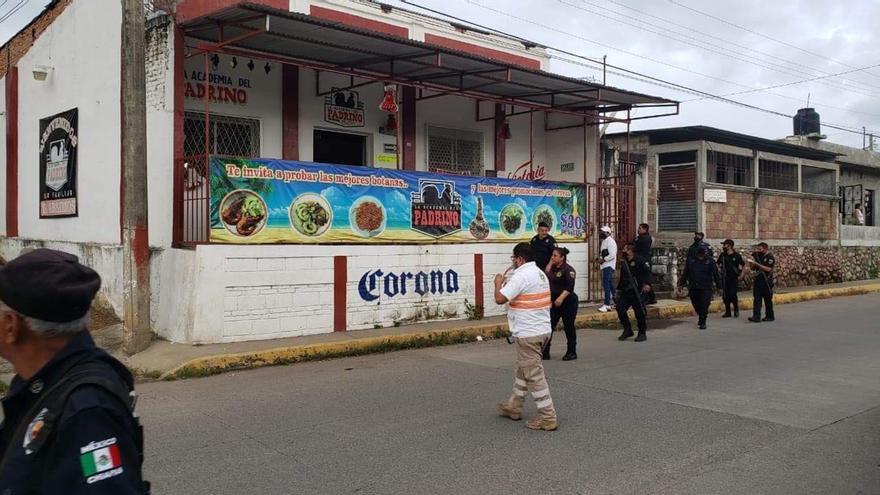
![]() 14ymedio/EFE, Mexico, 5 February 2024 — “Violations, sexual abuse, kidnappings and trafficking” is what thousands of migrants are exposed to as they pass through the border between Guatemala and Chiapas, in the south of Mexico, lawyer José Luis Pérez tells 14ymedio. On the way, some women are “kidnapped by drug cartels and forced into prostitution,” he adds.
14ymedio/EFE, Mexico, 5 February 2024 — “Violations, sexual abuse, kidnappings and trafficking” is what thousands of migrants are exposed to as they pass through the border between Guatemala and Chiapas, in the south of Mexico, lawyer José Luis Pérez tells 14ymedio. On the way, some women are “kidnapped by drug cartels and forced into prostitution,” he adds.
Chiapas ranks eighth in the crime of trafficking in Mexico. In 2020, 681 victims were registered in the state; the following year it rose to 753, and “in 2022 it shot up to 936 cases,” says the lawyer. In “the first half of 2023, there were 488 people affected by this crime,” he adds.
The lawyer emphasizes that “despair over the lack of money” and the delay of up to six months in immigration processes, “which many times” have a negative result, has also led Cubans, Venezuelans, Colombians and Haitians, for the most part, to offer “sexual services” in bars, canteens and nightclubs.
Genly, a Honduran migrant in Tapachula (Chiapas), worked in one of these bars that was closed on January 11 because it operated illegally. This 20-year-old migrant carried out her procedure before the Mexican Commission for Aid to Refugees (Comar) in December last year and was given an appointment for next March 27, so she was not handed over to the Migration agents.
This cartel hooked many of the foreigners in the ADO bus terminal with the promise of giving them work and helping them reach the border with the United States
It was not the case of Yalim, 29, and Anadelys, 42, “two Cubans who were waiting for their appointment for CBP One, but because they were illegal they were taken to the Siglo XXI immigration station,” located in Tapachula. Genly affirms that during the time he was working there, some armed men arrived in vans and took some of the women, especially young Venezuelans and Colombians. “They gave them money, cell phones and clothes and told them that they could process their documents.”
On January 14, 25 women were rescued in the state of Quintana Roo – including Cuban, Venezuelan, Colombian and Mexican – who were forced to prostitute themselves. According to the investigations, the Vaider bar, located at number 500 Isla de Capri Street in the municipality of Othón P. Blanco, in Chetumal, was controlled by the Caborca cartel.
“This cartel hooked many of the foreigners in the ADO bus terminal with the promise of giving them work and helping them get to the border with the United States,” Officer Alfredo Poot García told this newspaper.
The organization Caminantas, which serves migrants who cross through Mexico, reported last Saturday an increase in cases of trafficking of Colombians, Cubans and Venezuelans. The victims, activist Laura Cortés told the EFE agency, are caught through the same modus operandi: an acquaintance on the internet “who supports them financially at a distance, buys them tickets for the trip and sends them money for the family.” Once in Mexico they are raped.
Activist María Ángel Vielma said that many women also come to this country with the promise of a job and other false commitments. “The rapist is seeing what they need in order to manipulate them; the trap is disguised as love,” she said.
There is a selective xenophobia, we say, because if you are Central American, the treatment and pejorative comments are very ugly
Vielma explained that these cases are common among women who come from countries with economic crises or with nationalities about which there are stereotypes of female beauty. “There is a selective xenophobia, we say, because if you are Central American, the treatment and pejorative comments are very ugly. In contrast, if you are Colombian, Cuban or Venezuelan you are a sexy girl, the bomb, what they see on television that they think is a woman from these countries,” she stressed.
This could explain why of the 227 foreigners killed in Mexico from 2015 to 2023, 32 were Colombians and 29 Venezuelans, according to the National Public Security System.
According to figures from the National Institute of Migration, between 2018 and 2023 there were 160 victims of trafficking registered, of which 89 women and 35 men were victims of sexual exploitation.
Migration’s numbers on trafficking are “deceptive,” says lawyer José Luis Pérez. “They account for the cases that are reported, but there are many more victims who do not report out of fear.”
Translated by Regina Anavy
____________
COLLABORATE WITH OUR WORK: The 14ymedio team is committed to practicing serious journalism that reflects Cuba’s reality in all its depth. Thank you for joining us on this long journey. We invite you to continue supporting us by becoming a member of 14ymedio now. Together we can continue transforming journalism in Cuba.
